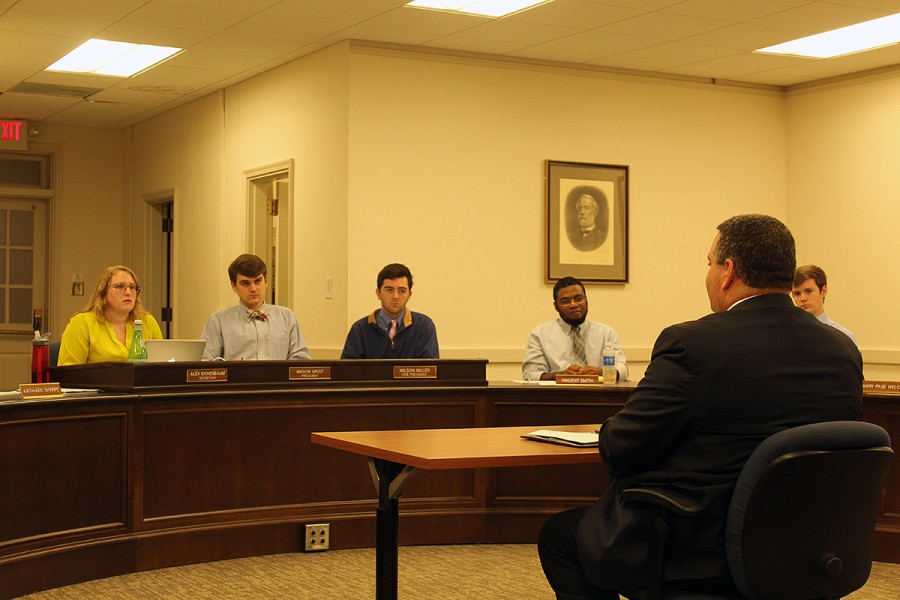New ‘LiveSave’ app puts students’ safety at their fingertips
App allows community members to share and access emergency info, receive support on-the-go
Ethan Kipnes, director of Public Safety, addresses the EC at its Sept. 28 meeting.
October 5, 2015
The Public Safety Department has unveiled a new tool for W&L students to actively engage in their campus safety experience.
The Washington and Lee University LiveSafe phone application helps community members share information, summon emergency support, access emergency information or virtually walk someone home.
The app seeks to “capitalize on the fact that students nowadays are walking around connected to their cell phones 24 hours a day,” W&L Director of Public Safety Ethan Kipnes said.
Kipnes said he believes students will more willingly and efficiently communicate with Public Safety using LiveSafe than through traditional methods like visiting the Public Safety office or having to personally call the Public Safety number.
The Class of 2019 was the first class to experience the app; speakers at the orientation week, a law enforcement panel educated students about the technology’s uses and encouraged them to take advantage of it.
“The LiveSafe app is a great resource for W&L students,” Emily Cohen,‘19, said. “It not only takes that extra step to keep students safe, but shows that the university really cares about student input.”
When students download the app, they gain access to a “WLU Resources” tab, which includes materials such as the university’s emergency management plan, Public Safety contact information and sexual assault assistance resources.
Under the “Report Tips” heading, users can choose from a variety of non-emergency categories or add their own and convey details of an issue using a text message, picture, video, or audio. Additionally, users have the option to send the report anonymously, giving students an unprecedented opportunity for privacy.
The “Emergency Options” feature enables users to instantly call 911 and call or message Public Safety. The app employs location services from phones to match users with their closest 911 call center and their local law enforcement, making response as quick and accurate as possible in case of an emergency.
One of LiveSafe’s most innovative characteristics is its “SafeWalk” program, which allows users to virtually walk a friend home. The app utilizes phone GPS to show a user when his or her friend has made it safely to his or her destination. Requests for a SafeWalk, which are external to Public Safety records, can be sent to anyone on a contact list, regardless of whether they download LiveSafe.
“Our students are great about looking out for each other,” Kipnes said. “LiveSafe is a great way to be an active bystander. Looking out for your friends and being able to report things to us in any way you feel comfortable to do so—that’s the way we’ve tried to market it so far.”
Another useful feature of the app is its location fluidity. If, for example, a W&L LiveSafe user visits a different college campus that also has LiveSafe set up, he or she can temporarily adjust to that school’s version of the app to gain instant connection to campus resources and local law enforcement.
Although LiveSafe is new to W&L, the idea behind the app has regional roots.
Kristina Anderson, one of the company’s co-founders, was a student at Virginia Tech who survived the 2007 shooting massacre and used her experience to fuel the technology’s development.
The company now markets its services to private enterprises, government agencies, and college campuses.
Within Virginia, Washington and Lee joins other schools like James Madison University, Virginia Tech and Old Dominion University as a client of LiveSafe.
In 2014, W&L reported three forcible sex offenses, one burglary, one drug violation with an arrest, 23 drug violations with disciplinary referrals and 35 liquor law violations with disciplinary referrals.
So far, Kipnes said he is pleased with the use he has seen of the app and said he hopes that it will catch on with more community members.
“Of the things that have been reported, I feel confident to say that at least three-quarters of them are things that wouldn’t have been reported to us in the past,” he said. “I attribute that to the fact that the app is right there, it’s easier, students feel comfortable just to text a quick message in.”



